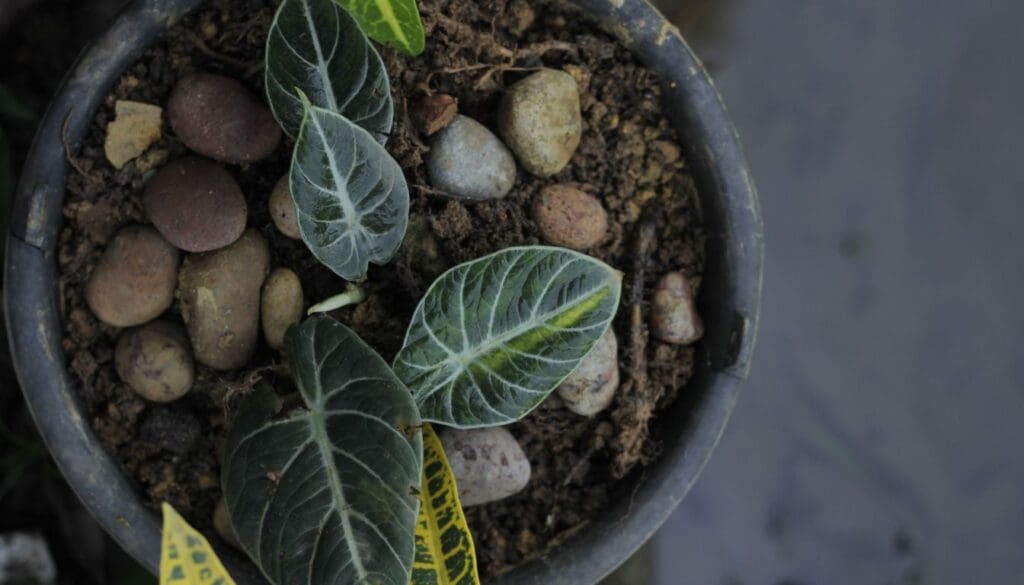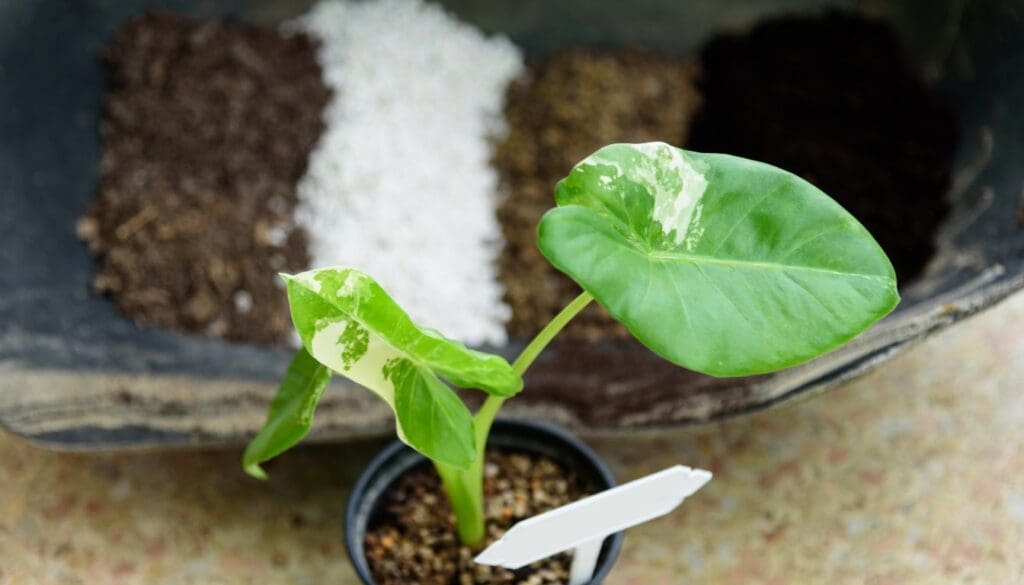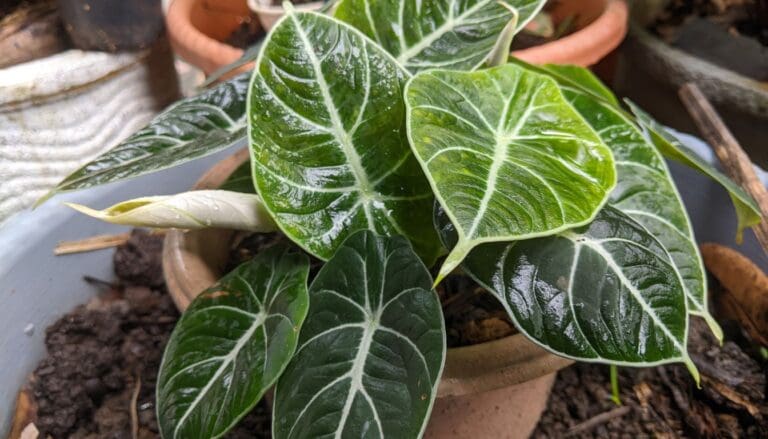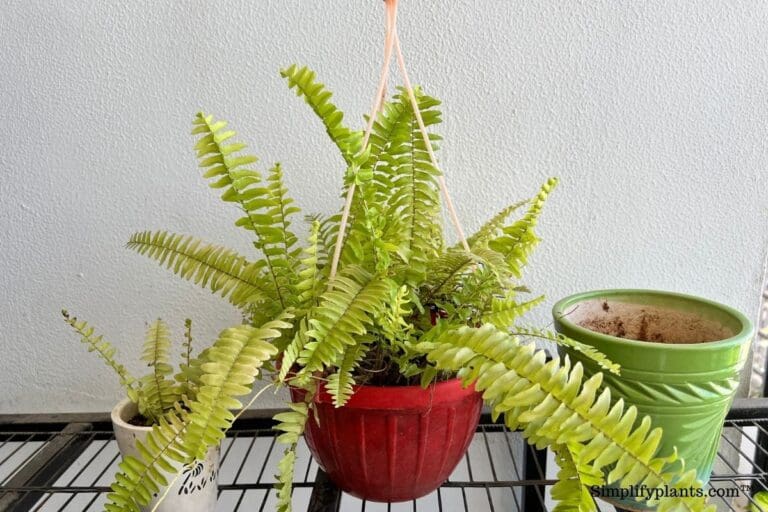Alocasia Not Growing New Leaves? 11 Causes & Easy Fix
Have you ever wondered why your Alocasia plant isn’t growing new leaves? In this article, we will talk about why this happens and share some simple ways to help your plant start growing again.
Alocasia doesn’t grow during the winter season as it stays dormant at that time. But other than that, inadequate lighting, incorrect watering, temperature fluctuations, repotting stress, insufficient nutrition, and pests are the common reasons hindering your alocasia growth.
You can make your alocasia grow by providing proper lighting, watering, and fertilizing them with liquid fertilizer on time.
Let’s explore the reasons behind stunted growth in alocasia and learn how to make your alocasia thrive with beautiful new leaves!

Please note: Simplify Plants is reader-supported. Some links in the post are affiliate links and I get a commission from purchases made through links in the post.
How fast does alocasia grow?
Alocasia is a fast-growing tropical plant, but only when provided with a proper growing condition.
Alocasia grows 3 to 5 ft. per year when planted outdoors and 1 to 2 ft. per year when planted indoors.
This plant can grow up to 8 ft. tall and takes at least 2 years to be completely mature.
Alocasias grow best during the summer and spring months as it is their growing season and doesn’t show any growth during the winter season.
Why is my alocasia not growing?
Something is still missing if your alocasia is not growing even after getting the proper growing conditions.
Don’t be worried after seeing your alocasia not growing.
Rather than worrying, try to find out what is wrong with your alocasia and fix it.
Let us see all the possible reasons behind poor growth in alocasia.
- Improper lighting
- Incorrect watering
- Inadequate fertilization
- Inappropriate soil mix
- Incorrect pot size
- Low humidity
- Low temperatures or temperature fluctuations
- Stress
- Pest infestations
- Lack of pruning
- Season
Now, let us discuss each of them in detail.
Improper lighting
Understanding proper light requirements for your alocasia is very important for the uninterrupted and healthy growth of the plant.
Alocasia grows best after 6 to 8 hours of bright indirect sunlight.
These plants can grow in low light but up to a certain limit.
Keeping alocasia in the dark makes growth difficult as photosynthesis slows down.
Insufficient light can lead to:
- Leggy growth
- Small leaves
- Weak stems
- Faded foliage
Overexposure to direct light also restricts the plant’s growth.
This can dehydrate the alocasia, making the plant weak, which causes poor growth and ill health.
Signs of excess light exposure on your alocasia:
- Scorched and crispy foliage
- Brown leaves
- Falling leaves
Also read: What Kind Of Light Does Alocasia Need? Alocasia Light Requirements
Incorrect watering

Incorrect watering interrupts the growth of your alocasia.
You should maintain a proper watering schedule for your alocasia’s healthy and proper growth.
Improper watering can lead to both underwatering and overwatering.
When your Alocasia experiences underwatering, the plant becomes dehydrated and fails to absorb water and nutrients from the soil.
Insufficient moisture and nutrients lead to weakness in alocasia, which leads to poor or no growth.
Common signs of underwatering:
- Dry, crispy foliage
- Brown leaves
- Falling leaves
In contrast, when alocasia experiences overwatering, the oxygen supply inside the soil reduces, which causes suffocation of the roots, and the plant will be prone to root rot disease.
Decaying roots fail to transfer moisture and nutrients to the plant, leading to poor growth in your alocasia.
- Wilting, brown
- Discolored foliage
- Foul-smelling soil
Also read: How To Water Alocasia Plant? (How Much, How Often & More)
Inadequate fertilization
Alocasia needs fertilization for faster and healthier growth.
Insufficient nutrition is one of the common reasons that don’t let the plant grow.
Soil does not contain all the nutrients your alocasia needs, so fertilizing your plant is necessary to provide the missing nutrients.
Alocasia needs fertilizer every 2 to 3 weeks in the summer and spring for optimum growth.
Signs of under-fertilization:
- Weak stems
- Scanty leaves
- Pale leaves
- Slow growth
Although alocasia requires proper fertilization, overdoing it will lead to overfertilization, which can cause severe health problems.
Frequent fertilization can damage the roots, and you can’t expect growth from a plant with unhealthy roots.
Overfertilization signs:
- A salt build-up in the soil surface
- Loss of leaves
- Yellow leaves
Also read: What Fertilizer To Use For Alocasia? (Ideal Fertilizer+Dosage Guide)
Inappropriate soil

Alocasia prefers well-draining soil that also has suitable moisture retention.
If the soil is inappropriate, alocasia will not be able to grow efficiently.
If the soil is heavy, it will absorb excess moisture that can cause overwatering.
This will lead to root rot disease, and the plant will stop growing due to decaying roots.
If the soil is too loose, roots will fail to absorb enough moisture and nutrients, leading to underwatering, and alocasia will stop growing.
Therefore, choosing the preferred soil mix for alocasia is necessary for its growth.
Also read: What Kind Of Soil Does Alocasia Need? (Ideal Soil Mix+Other Requirements)
Incorrect pot size
If your alocasia grows in the wrong size pot, it can face growth problems.
If the pot is too small for your alocasia, the roots lack enough space to grow, so the plant gets root-bound.
But when the pot is too big, it will hold more water and soil than required, which causes overwatering.
This will not let your alocasia grow properly; after a certain time, the plant will stop growing.
Also read: What Kind Of Pot For Alocasia? (Pot Material & Ideal Pot Size)
Low humidity
Alocasia, a tropical plant, needs a humidity level of at least 50-60% to thrive efficiently.
When the humidity level drops below this, the plant can experience growth issues.
Due to low humidity levels, the leaves lose moisture due to increased transpiration.
This dehydrates the plant, which leads to poor growth in alocasia.
Signs of low humidity:
- Leaf scorch
- Shriveling leaves
- Brown spots
- Crispy leaves
Also read: Should I Mist My Alocasia? (Ideal Humidity+How To Maintain)
Temperature fluctuations

Alocasia likes to stay in warm temperatures between 65-85°F.
When the temperature drops below 55°F, the alocasia starts facing growth problems.
Exposing your alocasia to temperature fluctuations or low temperatures can cause extreme stress to your plant as it fails to adjust itself in such an environment.
This affects the growth of alocasia.
This causes poor growth and can damage your entire plant, too.
So you should treat this problem as quickly as possible.
Stress
If your alocasia is experiencing any stress, it can affect its growth.
If you have repotted your alocasia recently, it becomes difficult for them to grow due to the sudden changing environment.
This can shock your plant for some days and stop its growth.
Other problems can also cause stress to your alocasia, such as:
- Temperature fluctuations
- Cold or hot drafts
- Changing location frequently
- Wind
Try to find out why your alocasia is stressed and relieve the plant from that problem.
Pest infestations
Pest is a serious problem that restricts the plant’s growth and kills the entire plant if not eliminated on time.
Pests are attracted to high temperatures, humidity, and overwatering.
If your alocasia experiences any of these, it can easily attract pests.
Pests like spider mites, aphids, mealybugs, and scales can attack your alocasia.
All these pests suck all the nutrients and moisture from the plant.
This causes weakness in alocasia, and the plant experiences poor growth.
Once pests attack your alocasia, it becomes difficult to treat them, so you should take action quickly.
Also read: How Do I Get Rid Of Bugs In Alocasia? (+Common Bugs Identification)
Lack of pruning

Not pruning your alocasia on time can stunt its growth.
You must prune alocasia frequently if you want your plant to grow even and bushy.
Due to the lack of pruning, the alocasia lacks space for new growth.
Not only this, damaged or diseased leaves also infect other healthy parts.
Not pruning properly can reduce growth in Alocasias and also cause weakness.
So, you should do this frequently.
Also read: Where To Prune Alocasia? (Best Time+How To)
Season
Alocasias grow best in their growing season, i.e., summer and spring.
But it slows their growth during the winter months.
It happens because alocasia experiences difficulty surviving, so they become dormant and prioritize saving themselves from cold climates rather than growing.
This is natural, so if your alocasia grows in winter, you don’t have to worry about it as it is their dormant period.
When the climate becomes quite warm, the plant will start to grow normally like it was before.
How can I make my alocasia grow?
Alocasia will grow efficiently with even speed if it gets the right care and the ideal conditions.
Alocasias are easy to care for but need proper attention to thrive.
Let us discuss all the ways that can encourage your alocasia’s growth.
Provide adequate light

Alocasia prefers 6 to 8 hours of bright indirect sunlight.
The light they get should not be too low or too intense.
Place your alocasia near the south or east-facing window.
This is the most preferred spot for providing light throughout the day.
Before keeping the plant near a window, cover it with a sheer curtain to filter the direct sunlight.
Keep your Alocasia 6-10 feet away from the window if the light is too intense. This will not stress your plant.
Keep rotating your plant to provide light to every part evenly.
You can also use artificial lights if the alocasia lacks natural light.
Correct watering
Alocasias need maximum watering during the summer and spring seasons.
When this plant is actively growing, you should check the moisture level frequently to find out whether your alocasia needs to be watered or not.
This plant needs watering only when the top layer of the soil is 25-50% dry.
You can check the moisture level with a moisture meter or insert your index finger into the soil.
You should thoroughly water your alocasia once a week until the water comes out from the drainage holes.
Avoid overwatering to keep alocasia away from root rot, pests, and fungal diseases.
If you have done it by any chance, stop watering for a few weeks.
Decrease watering during winter months; otherwise, the plant can get overwatered frequently.
If you have difficulties remembering when to water your alocasia, you can design a routine that reminds you to water the plant.
Add proper fertilizer

Alocasias need fertilizer from time to time for proper growth.
Use a 20:20:20 liquid fertilizer and apply it every month during the summer and spring seasons.
Make sure the fertilizer is diluted.
Otherwise, it is harmful to use strong doses.
Don’t fertilize your alocasia during the winter months.
If your plant is overfertilized, remove the excess fertilizer from the top layer of the soil and give the soil a good wash by watering thoroughly.
You can also repot the plant with new soil.
Maintain proper temperature
Alocasia thrives in warm temperatures.
You should try to maintain a temperature between 65-85°F.
Don’t keep the plant near a heating or cooling object like heaters, radiators, air conditioners, etc.
This can stress your alocasia because of the unusual temperature around them.
You can use a Hygrometer to check the temperature, as it measures both humidity and temperature.
This will help you know whether the alocasia is getting suitable temperatures or not.
Don’t keep your alocasia near a window during frosty climates and cold drafts.
Try to protect the plant from it.
Maintain humidity

Alocasia needs a humid environment to thrive.
This plant needs at least 50-60% of humidity level.
Regular misting can also help the Alocasia stay moisturized, but this requires effort and might not feel practical.
To maintain, you can group alocasia with other houseplants to increase humidity among the plants.
You can use a humidifier device to maintain humidity inside your house.
Choose the correct soil mix and pot size.
You should select a potting mix that is slightly acidic with a pH level of 5.5 and 6.5 for your alocasia.
Ensure the potting mix contains sufficient nutrients, proper drainage, and is well aerated.
The best soil mix for alocasia is:
- 1 part of peat moss
- 1 part of perlite
- 1 part of potting soil
Select a pot 1-2 inches bigger than the plant’s size.
This will provide sufficient space for the roots to grow.
Make sure the pot has a good drainage system to avoid frequent waterlogging.
Treatment of pests

You should watch out for pests to keep the alocasia away from them.
If pests have already attacked your plant, try to remove them as soon as possible.
You can wash the entire plant with a strong spray to eliminate most of these pests.
This will help wash away all the pests present in the plant.
You can rub the infected parts using cotton balls or cloth to remove the remaining pests.
Make sure you first dip it into the alcohol and then use it.
Insecticidal soaps can also help to remove pests from the plant.
Spray Neem oil or horticulture oil to remove the pests, and once they are gone, spray Neem oil once a month to prevent them.
Pruning on time
Pruning is very necessary for promoting healthy growth.
You should prune your alocasia regularly.
If you see any extra dead and diseased leaves, prune them off.
This will provide space for new growth in alocasia.
Always use sharp and sterilized scissors for pruning and ensure the cut is clean.
Otherwise, even a slight mistake can cause stress.
You should always prune occasionally to encourage even and healthy growth.
Take proper winter care.

Water your alocasia only when the soil is 75% dry.
Otherwise, the plant can get overwatered frequently during this time.
You should reduce watering during winter as the plants don’t consume much water during their dormant period.
Avoid fertilizing your alocasia, as this plant doesn’t need fertilizer during winter.
Keep the alocasia away from windows if the climate is extremely cold.
This can shock your plant.
Final words
Many reasons can stop your alocasia’s growth. Don’t get tense if you notice poor or no growth.
Always try to identify the problem that your alocasia is facing and then fix it accordingly.
Provide the ideal conditions for your plant and maintain all the factors, including proper water, light, and temperature. Make sure you don’t ignore any of the factors.
Otherwise, it can directly affect the plant’s growth.
Reference:Alocasia sanderiana, Alocasia micholitziana.
Recommended Garden Supplies
| Product Image | Our Recommended Gardening Supplies | Check Offers! |
|---|---|---|
Top Top
Top
Top
Top
Top
Top
Top
Top | rePotme Houseplant and Tropical Classic Potting Soil Mix | Check Offer On Amazon |
 Top
Top
Top
Top
Top
Top
Top
Top | Espoma Organic Indoor Plant Food | Check Offer On Amazon |
 Top
Top
Top
Top
Top
Top
Top
Top | GooingTop LED Grow Light 6000K Full Spectrum Clip Plant Growing Lamp | Check Offer On Amazon |
 Top
Top
Top
Top
Top
Top
Top
Top | Soil Moisture Meter | Check Offer On Amazon |
 Top
Top
Top
Top
Top
Top
Top
Top | Govee Hygrometer Thermometer, Bluetooth Enabled! | Check Offer On Amazon |
 Top
Top | LEVOIT Humidifiers for Large Room(Best For Plants) | Check Offer On Amazon |
 Top
Top
Top
Top
Top
Top
Top
Top | Upgraded DIY Automatic Drip Irrigation Kit, 15 Potted Houseplants Support | Check Offer On Amazon |
 Top
Top
Top
Top
Top
Top
Top
Top | Stainless Steel Heavy Duty Gardening Tool Set | Check Offer On Amazon |
 Top
Top
Top
Top
Top
Top
Top
Top | Bonide Insecticidal Soap | Check Offer On Amazon |
 Top
Top
Top
Top
Top
Top
Top
Top | Bonide 32 oz Spray Neem Oil for Organic Gardening | Check Offer On Amazon |
 Top
Top
Top
Top
Top
Top
Top
Top | Garden Safe Fungicide | Check Offer On Amazon |






